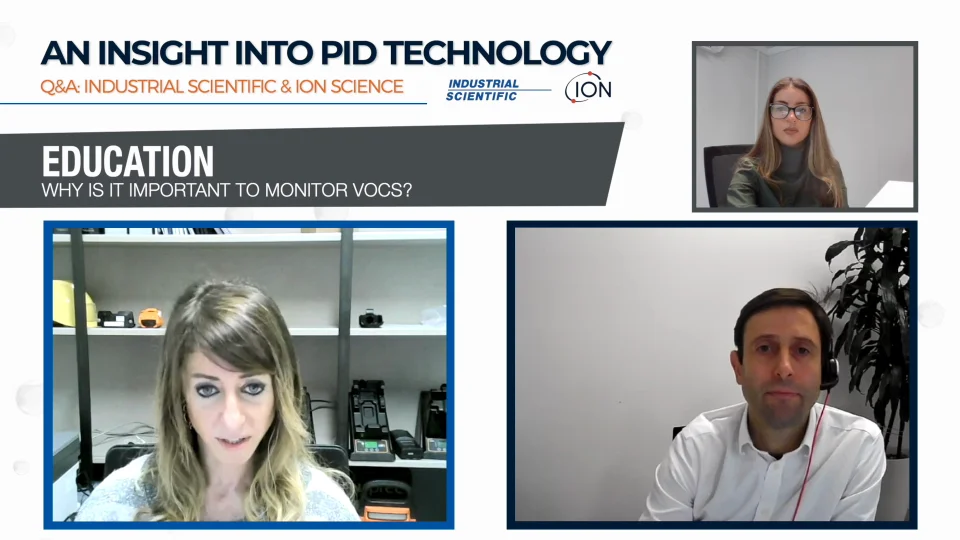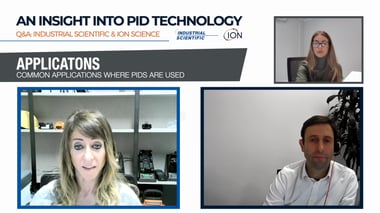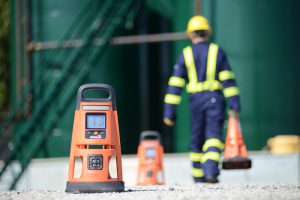Equipped with the latest, most accurate PID sensing technology from ION Science, the Ventis Pro5 from Industrial Scientific is now the most compact, versatile, and connected five-gas personal monitor available to reliably detect volatile organic compounds (VOCs). However, if you're considering adding the Ventis Pro5 with PID sensor to your fleet of gas monitoring equipment, there's a lot to consider about what's best for you and your facility—including why, how, what, where, and when to use this option for gas detection.
Join Ilaria Tramelli, business development director PID at Industrial Scientific, and Peter Morris, head of sensors at ION Science, as they discuss why it's important to monitor for VOCs.

Interested in learning more about PID technology? Click here to watch the full conversation between Industrial Scientific and ION Science.
Video Transcript
Moderator: Ilaria, would you inform our audience on what VOCs are?
Tramelli: VOCs stands for Volatile Organic Compounds. They are described as volatile because they evaporate at temperatures found on Earth, releasing molecules into the atmosphere. The lower the boiling point of a chemical the more readily it will evaporate or volatilize. Organic means that the compound contains carbon atoms. This covers a huge range of chemicals from simple molecules that contain a few atoms such ethylene to more complex, containing tens of atoms.
A volatile mixture most of us will be familiar with is petrol or gasoline. This is a complex mixture of lots of VOCs with different chemistries, boiling points, and, therefore, volatilities. As soon a petrol is spilt, we can pick up a sweet smell and unfortunately, this sweet smell comes from low boiling point compounds, which are benzene and its derivates as toluene, xylenes, ethylbenzene that are known as aromatic compounds because of their sweet smell. As time passes, the sweet smell will go as all the aromatics volatilize and the lower boiling fractions are all that remain.
There are various technical definitions of what a VOC is, usually we say "any organic compound having an initial boiling point less than or equal to 250°C measures at standard atmospheric pressure of 1.013 kPA.
Morris: Thanks, Ilaria. It's interesting, or useful to note, that VOCs are most familiar as manmade chemicals, but they also occur naturally. And in fact, more VOCs are produced by plants than anthropogenic sources by approximately four times the amount.
They play lots of essential roles in nature: The sweet nectar produced by plants to attract insects and birds for pollination is a VOC. We use VOCs and perfumes, perhaps for the same reason as plants. They're also used by plants for defense mechanisms, and they can keep herbivores away.
The most common biological emission is isoprene, and it helps protect plants from heat stress and scavenge oxygen and makes up about a third of all the VOCs released atmosphere on the planet. The VOCs that are manmade and also biological are also extremely important in the modern world. They form the building blocks of many synthetic materials including plastics, rubbers, glues and paints, are used to create pharmaceuticals, and are a great fuel for transport and heating. However, some of them do cause issues.
Moderator: Thanks, Pete. That's useful information. Why is it important to monitor VOCs Ilaria?
Tramelli: The main reason is for the impact the VOCs have on human health. And unfortunately the VOCs' toxicity is not always understood and monitored. VOCs have a specific STEL and TWA at ppm levels and they are listed in the same regulations adopted worldwide where the most common toxic compounds such as CO, H2S, and ammonia are listed too. I’m referring to OSHA, NIOSH, ACGIH for the U.S., EH40 for the U.K., and the Official Journal for the European Union.
Sometimes the impact of VOC exposure can be felt immediately. Acute effects include headache, dizziness, irritation of the eyes, and also death if the VOCs concentration is high and can deprive workers from oxygen, but frequently symptoms may not become apparent for months or years and this type of chronic illness can result from repeated and extended low level exposure. Chronic health effects includes damage to liver, kidney and the central nervous system. Some VOCs are also proven to be a carcinogen, so VOCs are a real problem.
If we think that the most common gas sensor configuration we have in personal gas monitors across all the industries is the four standard gases where we monitor the oxygen’s concentration, we monitor the ppm level of CO and H2S because both these compounds are toxic at ppm level and they can cause worker’s death and then we have the LEL Sensor. LEL sensors are known also as hydrocarbons sensors but this doesn’t mean that a LEL sensor will protect you from all the hazards coming from hydrocarbons; LEL sensor will protect you just from the flammability. It will inform you to leave the area if for some reasons you’re closed to have a flammable mixture but it won’t tell you if you’re exposed to ppm toxic levels of VOCs. This is because the LEL sensor is not the right technology to do that, it works in the flammability range so 0-100% LEL that equal to 0-5% Vol and if we think that 1% Vol is equal to 10.000 ppm we can understand that long before a concentration sufficient to be detected from a LEL sensor is reached, the toxic exposure limit has usually been exceeded.
Morris: It's really interesting. You're talking about the different types of risk, acute risks and chronic risks and as humans we're much more tuned in to immediate risks rather than long term threats. So we're more likely to spend money on protecting ourselves from an immediate threat as opposed to a long term threat. For example, we spend money quite rapidly and easily on protecting our home from a burglar threat or fitting an alarm or a security door. But we're much less likely to get a radon detector to protect us from long term radiation threats because they just don't seem as real to us.
Tramelli: Yeah, that's right. I mean, if we think about refineries, chemical plants and many other industrial environments, the most common hydrocarbons we can find there are medium/heavy hydrocarbons such as toluene, xylene, styrene, benzene, cyclohexane, DMF, trichloroethylene, phenol, and many others. All these hydrocarbons are flammable for sure, but they are also toxic. The toxicity of benzene is known, it has a TWA of 1 ppm but what about toluene, xylene? They have a TWA of 50ppm and LEL sensor cannot help here, it’s not sensitive enough.
Moderator: So we've just discussed the impact that VOCs can have on human health. But many of these can also pose an environmental risk. Is this correct, Pete?
Morris: Yeah, that's right. VOCs can pose a significant environmental risk. VOCs are, as Ilaria just discussed, harmful themselves. But they can react with other chemicals, such as nitrogen dioxide (NO2), to create secondary pollutants; and these things can play key roles in the pollution in the formation of photochemical smog.
A secondary pollutant of great concern is ground level ozone. While ozone is produced naturally in the upper atmosphere and is really important to protect us from harmful levels of radiation, it's very dangerous at low concentrations at ground level for both animal and plant life. It can really affect our respiratory systems. Many other hazardous substances are also formed, including secondary organic aerosols, which are known to increase cardiovascular and respiratory disease. Peroxyacetyl Nitrate, commonly known as PAN, is also created, and this can act as a nitrogen dioxide reservoir and can transport nitrogen dioxide from polluted regions to remote regions and produce ozone by interacting with biogenically produced VOCs far from the original source with high efficiency, and this is manifested in bleaching forests and ruining crops. Due to our increased awareness of the direct health effects of the gases as a primary pollutant and their role in secondary pollutants, there's an ever increasing need to monitor them.
Tramelli: I will add that this is really interesting because human emissions of carbon dioxide and other greenhouse gases are a primary driver of climate change. But it's important to know that VOCs are considered to be a contributor to global warming as well.
Interested in learning more about PID technology? Click here to watch the full conversation between Industrial Scientific and ION Science.



